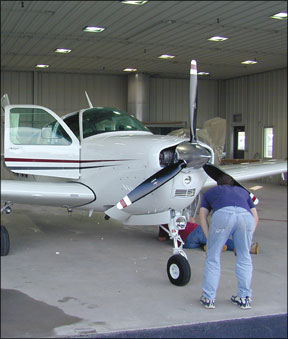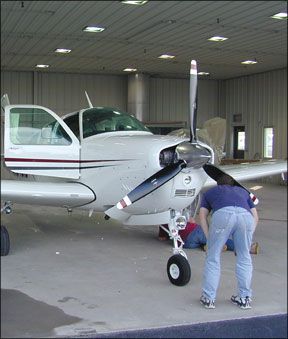At some point during aircraft ownership, owners are faced with the prospect of a post-maintenance flight test with a technician or shop representative riding shotgun. Depending on the level of maintenance the shop performed on the aircraft, a lot can go astray-and were not just talking about in-flight emergencies (although the odds of one are higher after heavy maintenance). And even relatively simple owner-performed maintenance chores, like oil changes or brake-pad replacement, have been known to create airborne drama.

288
Whenever an aircraft comes out of maintenance, some sort of test flight should be conducted with the idea of verifying the work performed. In fact and perhaps unsurprisingly, the FAA has a regulation covering post-maintenance test flights, FAR 91.407. Its applicability to a specific situation hinges on the extent to which, if any, work on the aircraft “appreciably changed its flight characteristics or substantially affected its operation.” Thats a fairly broad definition, and one an owner should think about whenever some maintenance is planned.
But thats not all. Areas requiring consideration and planning for a post-maintenance test flight include piloting currency, insurance coverage, crew coordination and other FAA regulations, to name a few. For example, another regulation, FAR 91.305, states flight testing must be conducted over open water, or sparsely populated areas having light air traffic.
Lets also get one thing out of the way early: Allowing a maintenance facility to casually fly your aircraft on their own should be out of the question. Further, maintenance technicians might have reservations about flying with some owners-there could be a good reason.
Why Play Test Pilot?
It should go without saying that every time you retrieve your aircraft from maintenance, you are launching on a flight test. But major system upgrades, especially avionics work, often require structured in-flight testing as part of the return-to-service process.
While a fair amount of testing can be accomplished on the ground utilizing ground test equipment including navigation signal generators, GPS signal repeaters and autopilot test equipment to name a few, the real test of system integration happens in the flight environment, where workload can be staggering. Further, many avionics component installation procedures, including STC data, call for in-flight testing. The popular Garmin GNS530W system post-installation checkout, for example, calls for a flight check to evaluate ILS, GPS, communications and autopilot coupling performance.
If an FAA field approval is the ultimate goal, a FSDO might want to see data recorded from a flight test as part of the approval data. Its not uncommon for flight-test data forms, which prove system accuracy, to be added to the aircraft flight manual and permanent records. But avionics work isnt the only maintenance that can induce flight-testing. Owners might want a mechanic on board to witness performance of a new engine installation. Perhaps the owner wants the mechanic to witness first hand a weird discrepancy or abnormality in the engine or airframe. Commonly, the mechanic/owner communication chain can become distorted, and sometimes the only way to describe a problem is to take flight for a first-hand look at a discrepancy.
Control the Environment
Heres a common scenario: Your airplane has been in the shop for weeks-maybe months-for a major systems upgrade. Its likely the machine has been in pieces all over the hangar floor with multiple technicians having their hands in the mix. Maybe you combined an avionics upgrade with some engine work, taking advantage of the downtime. Your concerns are now two-fold, since both electrical systems and engine have been altered.
For your own education, it pays to visit with the shop during the project to have a better understanding of both the level of disassembly and whos working on the aircraft. Good shops will understand you are placing your life in their hands in paying them to wrench your aircraft and should welcome you, within reason and without distraction, to visit.
Straight up, its an absolutely imperfect idea to plan an important trip with the aircraft right after major maintenance. Doing so will introduce stress for you and your maintenance people. The other side of this coin is youll want reasonably good daylight VMC conditions for maintenance flight-testing-you obviously cant rely on decent weather on the day you plan to fetch the aircraft for a test hop. Its foolish to flight test in IFR conditions, so dont do it. In areas of the country where winter is really winter, VFR days can be few and far between. Plus, dusk comes early-limiting the available time youll have to conduct the flight even if the weather is good VFR. So if the shop tentatively plans to perform the flight test on a certain day, add liberal amounts of time for both work and weather delays.
As for the flight test itself, it could be as simple as a circuit around the traffic pattern to test an engine, or as complex as flying multiple instrument procedures to certify a suite of newly installed avionics. You want to do an extremely thorough preflight and a watchful run-up. When its time to depart, utilize ATC services for the testing. Ask for a transponder code assignment for flight following, and advise the controller that the mission is a maintenance flight test. The obvious concern for testing systems in flight is the tendency for large amounts of heads down time-watching all those newly installed glass displays and their pretty colors when your attention should be focused outside the aircraft. Let the technician push the buttons while you fly the airplane and watch for traffic.
Whos in Charge Here?
You, the owner of the aircraft are the pilot in command on any flight test. In the avionics retrofit world this situation can become distorted and deserves frank discussion before you board the aircraft. An owner might show up to find his upgraded cockpit to be completely foreign-almost like a different airplane. This presents a steep learning curve and the natural fallback is to look to the avionics technician as a flight instructor.
Instead, you should have planned for this days or weeks earlier, and obtained the pilots guide for the newly installed equipment so you can become familiar with the gear before you launch. For certain, flight-testing is not an environment to be conducting training, and avionics shops are not in the flight training business.
While its sometimes prudent for a savvy technician to explain the button pushing along the way, dont assume the technician can fly the airplane or has any command over the aircraft. If the tech is a pilot, its helpful to split the cockpit chores. While you fly the aircraft, maybe the tech can participate in the checklist chores, talk on the radios, and program the equipment. It should go without saying that flying the airplane is the first priority.
The flight test is not the time to become re-current in the airplane. Since upgrades and heavy maintenance can cause a sizeable lapse in flying experience, you might show up for the flight test out of legal or comfortable currency. Before you carry passengers-and this includes the technician-fly the aircraft around the traffic pattern a few times and then return for the testing. Do show up prepared with current charts and pilot credentials (its not out of line for a shop to ask to see your pilot certificate and current medical-this has been suggested by some FAA officials).
Be sure the aircraft Flight Manual, a current and accurate weight and balance report, and airworthiness and registration are on board. This paperwork tends to get displaced during long periods of maintenance. Good shops take extra care to ensure the safeguarding of this paperwork, and its your duty to be sure they go along on the flight test. A shop must issue a maintenance release before an airplane can take flight. If the aircraft were to crash, this is one of the first documents inspectors will want to see.
Second Thoughts
Realize that when you show up for a flight test, most technicians will have a keen eye for the way you approach your flying. In fact, after just a few minutes of conversation theyll likely be able to tell if youre someone they want to fly with-or not.
We recall one misinformed owner who insisted the shop fly with him so he could prove the vacuum had leaked out of his gyro and it needed to be refilled. Some other memorable moments: A red-eyed doctor (yes, he owned a V-tail Bonanza) showed up for a flight test after working two days at the hospital without sleep. Then there was the gruff, chain-smoking ferry pilot who was hired not only to deliver a Piper Malibu to its new owner, but to also fly the airplane with the shop to test some newly installed avionics. When he settled into the pilots seat, the technician asked if he was going to check the engine oil. You can imagine the technicians concern when the pilot replied, “Nah, its a Malibu-I dont bother, if the #@&! thing is going to quit, its going to quit.”
Another owner boldly showed up to fly his newly purchased Cessna Centurion after the shop pointed out several cracks in the turbocharger, aileron control cables so loose they were dragging on the bottom of the wing structure, and a melted oil line. Still, he couldnt understand why the shop wouldnt fly the airplane with him. Yet another technician had a tale teetering the boundaries of reality and sheer fantasy. Seems one female owner, obviously smitten by the young technician, used a troubleshooting flight test as an opportunity to join the mile-high club, once the aircraft settled into cruise with the autopilot engaged. Fascinating.
In any case, once in the aircraft, advise the technician to speak up if you do anything that makes them feel uncomfortable at any time during the flight. Whats important to remember is that not all technicians are pilots and theyll have the same fears as non-flyers. Moreover, they have intimate knowledge of areas that could go wrong during a flight, adding to their concerns. And lastly, if a technician outright refuses to fly the aircraft with you, ask why. Is it the aircraft they have concerns about? Is it their perception of your piloting skills? If no one from the shop wants to fly with you or in your aircraft, there is definitely something suspicious about you or your aircraft.
Conclusion
Nearly all seasoned aircraft technicians have stories of flight-testing terror, with gray hairs as proof. From a test ride in an aircraft whose pilot ran it out of fuel, to an encounter with the tops of 100-foot-tall pine trees with an owner who misread the altimeter during an approach at dusk, the risk can be really high.
To help reduce the risk, ask your maintenance shop if a flight test is really necessary. Often, thorough ground runs are a better and more cost-effective way to troubleshoot. Speaking of costs, many shops charge a fee for flight-testing. And lastly, most technicians boast of skillful pilots they would fly with any day of the week. These are attentive, responsible and careful owners who take flight-testing chores seriously-respecting the machine and technician alike. In our view, this is the only way to approach the serious and risky task of maintenance fly-offs.
Larry Anglisano is an avionics technician and
Aviation Consumer contributor whos flown his share of post-maintenance test flights.



